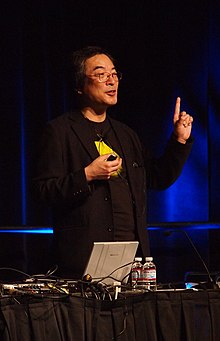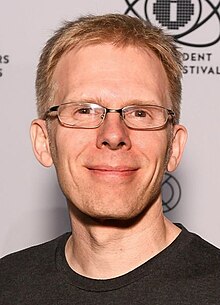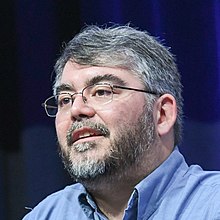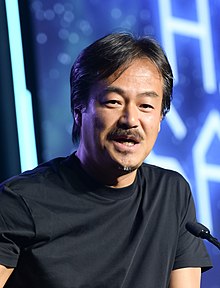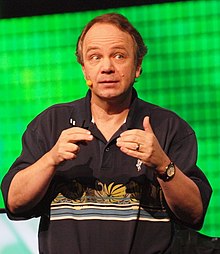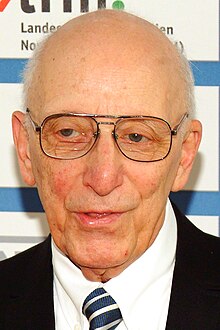Portal:Video games
Portal maintenance status: (April 2019)
|
The Video Games Portal

A video game, sometimes further qualified as a computer game, is an electronic game that involves interaction with a user interface or input device (such as a joystick, controller, keyboard, or motion sensing device) to generate visual feedback from a display device, most commonly shown in a video format on a television set, computer monitor, flat-panel display or touchscreen on handheld devices, or a virtual reality headset. Most modern video games are audiovisual, with audio complement delivered through speakers or headphones, and sometimes also with other types of sensory feedback (e.g., haptic technology that provides tactile sensations). Some video games also allow microphone and webcam inputs for in-game chatting and livestreaming.
Video games are typically categorized according to their hardware platform, which traditionally includes arcade video games, console games, and computer games (which includes LAN games, online games, and browser games). More recently, the video game industry has expanded onto mobile gaming through mobile devices (such as smartphones and tablet computers), virtual and augmented reality systems, and remote cloud gaming. Video games are also classified into a wide range of genres based on their style of gameplay and target audience. (Full article...)
Featured articles – load new batch
-
Image 1God of War is an action-adventure game franchise created by David Jaffe and developed by Sony's Santa Monica Studio. It began in 2005 on the PlayStation 2 (PS2) video game console and has become a flagship series for PlayStation, consisting of nine installments across multiple platforms. Based on ancient mythologies, the series' plot follows Kratos, a Spartan warrior who becomes the God of War and comes into conflict with various mythological pantheons. The earlier games in the series are based on Greek mythology and see Kratos follow a path of vengeance against the Olympian gods; the later games are based on Norse mythology and see Kratos on a path of redemption while also introducing his son Atreus as a secondary protagonist, as they come into conflict or interact with various Norse deities and figures.
Santa Monica Studio has developed all main entries, while Ready at Dawn and Javaground/Sony Online Entertainment-Los Angeles (SOE-LA) developed the three side games. Sony Interactive Entertainment (SIE) has published all games except the mobile phone installment, which was published by Sony Pictures Digital. The first seven games make up the Greek era of the franchise. God of War (2005), God of War II (2007) and God of War III (2010) comprise its main trilogy; the first two were released on the PS2 with the third on the PlayStation 3 (PS3). A prequel, Ascension (2013), was also released for the PS3. Other games include Chains of Olympus (2008) and Ghost of Sparta (2010) for the PlayStation Portable (PSP) and Betrayal (2007) for mobile phones that supported the Java Platform, Micro Edition (Java ME). The Norse era began with the 2018 game God of War, which was released for the PlayStation 4 (PS4) and later Windows in January 2022. It was accompanied by a short prequel, A Call from the Wilds (2018), a text-based game through Facebook Messenger. A sequel, Ragnarök, was released in November 2022 for the PS4 and PlayStation 5 (PS5) and concluded the Norse era, which received an epilogue in the form of an expansion pack titled Valhalla in December 2023; a Windows port of Ragnarök was released in September 2024.
Games in the series have been praised as some of the best action games of all time. The series has received numerous awards, including several Game of the Year recognitions for the 2005 and 2018 installments. Some games have also been remastered for newer PlayStation platforms. As of November 2023, the franchise has sold an estimated 66+ million games worldwide, and is PlayStation's most profitable first-party brand. Strong sales and support of the series led to the franchise's expansion into other media, such as three comic book series and three novels. A film adaptation of the original installment had been in development but was ultimately canceled; however, a television series adaptation of the Norse era is in development for Amazon Prime Video. Merchandise includes artwork, clothing, toys, and prop replicas, as well as the games' soundtracks, including a heavy metal album, Blood & Metal (2010), featuring original music by various bands, who were inspired by the series. (Full article...) -
Image 2Final Fantasy Type-0 is a 2011 action role-playing game developed and published by Square Enix for the PlayStation Portable (PSP). Released in Japan on October 27, 2011, Type-0 is part of the Fabula Nova Crystallis subseries, a set of games sharing a common mythos which includes Final Fantasy XIII and XV. The gameplay, similar to Crisis Core: Final Fantasy VII, has the player taking control of characters in real-time combat during missions across Orience. The player also engages in large-scale strategy-based battles on the world map, and has access to a multiplayer option during story missions and side quests.
The story focuses on Class Zero, a group of fourteen students from the Vermillion Peristylium, a magical academy in the Dominion of Rubrum. When the Militesi Empire launches an assault on the other Crystal States of Orience, seeking to control their respective crystals, Class Zero is mobilized for the defense of Rubrum. Eventually, the group becomes entangled in the secrets behind both the war and the reason for their existence. The setting and presentation were inspired by historical documentaries, and the story itself was written to be darker than other Final Fantasy titles.
The game was originally announced as a title for mobile phones and the PSP called Final Fantasy Agito XIII. It was directed by Hajime Tabata, who took up the project after completing Before Crisis: Final Fantasy VII. Initially designed to provide players with easy access to the Fabula Nova Crystallis universe, the mobile version was eventually cancelled and the game's title was changed to distance it from the subseries' flagship title Final Fantasy XIII. Releasing to strong sales, it received praise for its story and gameplay, but was criticized for its camera control and artificial intelligence. Further games related to Type-0 have also been developed, including a high definition remaster that was released internationally in March 2015. (Full article...) -
Image 3Mario Party DS is a 2007 party video game developed by Hudson Soft and published by Nintendo for the Nintendo DS. It is the second handheld game in the Mario Party series, as well as the last game in the series to be developed by Hudson Soft, as all subsequent titles have been developed by Nintendo Cube. The game was re-released on the Virtual Console for the Wii U in 2016.
Like most installments in the Mario Party series, Mario Party DS features characters from the Mario franchise competing in a board game with a variety of minigames, many of which utilize the console's unique features. Up to four human players can compete at a time, though characters can also be computer-controlled. The game features a single-player story mode as well as several other game modes.
Mario Party DS received mixed reviews, with general praise for its minigame variety and criticism for its absence of an online multiplayer mode. The game has sold more than nine million units worldwide, making it the 11th-best-selling game for the Nintendo DS. Mario Party DS was succeeded by Mario Party 9 for the Wii in 2012. (Full article...) -
Image 4Flight Unlimited II is a 1997 flight simulator video game developed by Looking Glass Studios and published by Eidos Interactive. The player controls one of five planes in the airspace of the San Francisco Bay Area, which is shared with up to 600 artificially intelligent aircraft directed by real-time air traffic control. The game eschews the aerobatics focus of its predecessor, Flight Unlimited, in favor of general civilian aviation. As such, new physics code and an engine were developed, the former because the programmer of Flight Unlimited's computational fluid dynamics system, Seamus Blackley, had left the company.
The team sought to create an immersive world for the player and to compete with the Microsoft Flight Simulator series. Commercially, Flight Unlimited II performed well enough to recoup its development costs. Critics lauded the game's graphics and simulated airspace, and several praised its physics. However, some considered the game to be inferior to Microsoft Flight Simulator 98. Following the completion of Flight Unlimited II, its team split up to develop Flight Unlimited III (1999) and Flight Combat (later Jane's Attack Squadron) simultaneously. Both projects were troubled, and they contributed to the closure of Looking Glass in May 2000. (Full article...) -
Image 5Midtown Madness (also known as Midtown Madness: Chicago Edition) is a 1999 racing game developed by Angel Studios and published by Microsoft for Microsoft Windows. The demo version was released in April 1999. Two sequels followed, with Midtown Madness 2 released in September 2000 and Midtown Madness 3 released in June 2003 for the Xbox. The game is set in Chicago; the object is for the player to win street races and obtain new cars.
Unlike racing games that restrict the player to a race track, Midtown Madness offers an open world recreation of Chicago. This setting was said to provide "an unprecedented degree of freedom to drive around in a virtual city". Players can explore the city using one of several modes and can determine the weather and traffic conditions for each race. The game supports multiplayer races over a local area network or the Internet. The game received generally positive reviews from gaming websites. Angel Studios developed another video game featuring open-world recreations of cities, Midnight Club: Street Racing. (Full article...) -
Image 6

Pirates of the Caribbean: Armada of the Damned is a cancelled action-adventure role-playing video game that was being developed by Propaganda Games for the PlayStation 3, Xbox 360, and Microsoft Windows platforms. Originally set to be published by Disney Interactive Studios, it was the first attempt to create an open world game based on the Pirates of the Caribbean film franchise. The project was cancelled in October 2010, soon before the closure of Propaganda Games.
Set roughly ten or fifteen years before events of The Curse of the Black Pearl, the game was to follow James Sterling, a pirate captain whose main mission was to travel across the Caribbean Sea to make a reputation for himself. Although little was unveiled about the story, it was intended to be independent from the films' main arc and include new characters. Gameplay was to have emphasized role-playing elements, including real-time combat and weapon customization.
After its announcement at 2009's Electronic Entertainment Expo, the game received positive responses from most video game journalists. Daemon Hatfield from IGN thought it "a promising action RPG", while GamesRadar praised the gameplay, comparing it to the Assassin's Creed franchise. Journalists were disappointed when Disney cancelled the game several months before its planned release date. Ubisoft, the publisher of Assassin's Creed, later released Assassin's Creed IV: Black Flag with similar role-playing gameplay elements. (Full article...) -
Image 7
The Nintendo DSi is a dual-screen handheld game console released by Nintendo. The console launched in Japan on November 1, 2008, and worldwide beginning in April 2009. It is the third iteration of the Nintendo DS, and its primary market rival was Sony's PlayStation Portable (PSP). The fourth iteration, entitled Nintendo DSi XL, is a larger model that launched in Japan on November 21, 2009, and worldwide beginning in March 2010. Development of the DSi began in late 2006, and the handheld was unveiled during an October 2008 Nintendo conference in Tokyo. Consumer demand convinced Nintendo to produce a slimmer handheld with larger screens than the DS Lite. Consequently, Nintendo removed the Game Boy Advance (GBA) cartridge slot to improve portability without sacrificing durability.
While the DSi's design is similar to that of the DS Lite, it features two digital cameras, supports internal and external content storage, and connects to an online store called the Nintendo DSi Shop. Nintendo stated that families often share DS and DS Lite consoles. Its new functionality was intended to facilitate personalization, so as to encourage each member of a household to purchase a DSi. The handheld supports exclusive physical media in addition to DS games with DSi-specific features and standard DS titles. The only exception to its backward compatibility are earlier DS games that required the GBA slot. Nintendo sold over 41 million DSi and DSi XL units combined. They were succeeded by the Nintendo 3DS.
Reviews of the Nintendo DSi were generally positive; IGN and bit-tech decried the console's lack of exclusive software and removal of the GBA cartridge slot, though its added functionality caused many journalists to recommend it to those who had not purchased a previous DS model. Numerous critics were disappointed with the limited resolution of DSi's cameras, though others such as Ars Technica and GameSpot agreed they were adequate for the handheld's display. CNET and PCWorld considered the DSi Shop to be the most important buying incentive for current DS owners. Some critics believed the DSi XL was not an essential upgrade. GamePro and Wired UK, on the other hand, praised the DSi XL's larger screens for improving the gameplay experience and revitalizing older DS games. (Full article...) -
Image 8

The 32X is an add-on for the Sega Genesis video game console. Codenamed "Project Mars", it was designed to expand the power of the Genesis and serve as a transitional console into the 32-bit era until the release of the Sega Saturn. The 32X uses its own ROM cartridges and has its own library of games. It was distributed under the name Super 32X in Japan and South Korea, Genesis 32X in North America, Mega 32X in Brazil, and Mega Drive 32X in all other regions.
Sega unveiled the 32X at the Consumer Electronics Show in June 1994, and presented it as a low-cost option for 32-bit games. It was developed in response to the Atari Jaguar and concerns that the Saturn would not make it to market by the end of 1994. Though the 32X was conceived as a new, standalone console, at the suggestion of Sega of America executive Joe Miller and his team, it became an add-on for the Genesis and made more powerful. The final design contained two 32-bit central processing units and a visual display processor.
The 32X failed to attract third-party video game developers and consumers because of the announcement of the Saturn's simultaneous release in Japan. Sega's efforts to rush the 32X to market cut into time for game development, resulting in a weak library of 40 games that did not fully use the hardware, including Genesis ports. Sega produced 800,000 32X units and sold an estimated 665,000 by the end of 1994, selling the rest at steep discounts until it was discontinued in 1996 as Sega turned its focus to the Saturn. (Full article...) -
Image 9
League of Legends (LoL), commonly referred to as League, is a 2009 multiplayer online battle arena video game developed and published by Riot Games. Inspired by Defense of the Ancients, a custom map for Warcraft III, Riot's founders sought to develop a stand-alone game in the same genre. Since its release in October 2009, League has been free-to-play and is monetized through purchasable character customization. The game is available for Microsoft Windows and macOS.
In the game, two teams of five players battle in player-versus-player combat, each team occupying and defending their half of the map. Each of the ten players controls a character, known as a "champion", with unique abilities and differing styles of play. During a match, champions become more powerful by collecting experience points, earning gold, and purchasing items to defeat the opposing team. In League's main mode, Summoner's Rift, a team wins by pushing through to the enemy base and destroying their "Nexus", a large structure located within.
League of Legends has received generally positive reviews; critics have highlighted its accessibility, character designs, and production value. The game's long lifespan has resulted in a critical reappraisal, with reviews trending positively; it is widely considered one of the greatest video games ever made. However, negative and abusive in-game player behavior, criticized since the game's early days, persists despite Riot's attempts to fix the problem. In 2019, League regularly peaked at eight million concurrent players, and its popularity has led to tie-ins such as music, comic books, short stories, and the animated series Arcane. Its success has spawned several spin-off video games, including a mobile version, a digital collectible card game, and a turn-based role-playing game, among others. A massively multiplayer online role-playing game based on the property is in development. (Full article...) -
Image 10Satoru Iwata (Japanese: 岩田 聡, Hepburn: Iwata Satoru, December 6, 1959 – July 11, 2015) was a Japanese businessman, video game programmer, video game designer, and producer. He was the fourth president and chief executive officer (CEO) of Nintendo from 2002 until his death in 2015. Iwata was a major contributor in broadening the appeal of video games by focusing on novel and entertaining games rather than top-of-the-line hardware.Iwata at Game Developers Conference in 2011
Born in Sapporo, Iwata expressed interest in video games from an early age and created his first simple game while in high school. He majored in computer science at the Tokyo Institute of Technology. In 1980, he joined the game developer HAL Laboratory while attending the university. At HAL, he worked as a programmer and closely collaborated with Nintendo, producing his first commercial game in 1983. Games to which he contributed include EarthBound and many games in the Kirby series. Following a downturn and near-bankruptcy, Iwata became the president of HAL in 1993 at the insistence of Nintendo president Hiroshi Yamauchi and brought financial stability. In the following years, he worked in the development of the Pokémon and Super Smash Bros. series. Iwata joined Nintendo as the head of its corporate planning division in 2000.
Nintendo saw growth under Iwata and, when Yamauchi retired, he became the company's president in May 2002. Under Iwata's direction, Nintendo developed the Nintendo DS and Wii game consoles, helping the company achieve financial success. As a self-declared gamer, he focused on expanding the appeal of video games across demographics through a "blue ocean" business strategy. Nintendo attained record profits by 2009, and Barron's placed Iwata among the top 30 CEOs worldwide. Iwata expanded his strategy by defining a quality-of-life product line for the Wii that evolved into a ten-year strategy to create standalone products. Later hardware such as the Nintendo 3DS and Wii U proved far less profitable than the Wii, and Nintendo's net sales fell by two thirds from 2009 to 2012; the company saw its first operating losses in 30 years during this time. Iwata voluntarily halved his salary in 2011 and again in 2014. In 2015, after several years of refusal, Iwata put a portion of Nintendo's focus into the rapidly growing mobile game market; a landmark partnership with mobile provider DeNA was established that March. Throughout his career, Iwata built a relationship with Nintendo fans through social media and his regular appearances in Iwata Asks and Nintendo Direct, becoming the public face of the company. (Full article...)
Did you know... - show different entries
- ... that a pink skin for Mercy in the video game Overwatch helped raise more than $12 million for breast cancer research?
- ... that the game designer of the video game Hades said that the characters were attractive "because Jen Zee"?
- ... that Rawson Stovall became the first nationally syndicated video game journalist in the United States when he was only eleven years old?
- ... that the concept of adding strippers to the extreme sports video game BMX XXX was initially proposed in jest?
- ... that Rockstar Vienna was the largest video game developer in Austria when it closed in 2006?
- ... that Paul Dini was a writer for both the animated television series Batman: The Animated Series and the video game series Batman: Arkham?
- ... that the 2005 video game Bokura no Kazoku was inspired in part by the birth of its creator's first child?
- ... that the success of Kingdom Rush prompted plans to grow the video game industry of Uruguay?
- ... that the science-fiction video game The Anacrusis is named after a musical term?
- ... that Terra Invicta's development company is a group of former volunteer video game modders that decided to release their own game after the success of their mod?
- ... that for at least 90 minutes, Mori Calliope livestreamed herself begging video game developer Atlus to allow her to stream their game Persona 3?
- ... that development on the video game Expeditions: Rome was not affected by lockdowns from the COVID-19 pandemic because the developer was already split between Copenhagen and Istanbul?
Selected biography – load new batch
-
Image 1
Richard Allen Garriott (born 4 July 1961) is a British-born American video game developer, entrepreneur and private astronaut.
Garriott, who is the son of NASA astronaut Owen Garriott, was originally a game designer and programmer, and is now involved in a number of aspects of computer-game development. On October 12, 2008, Garriott flew aboard the Soyuz TMA-13 mission to the International Space Station as a private astronaut, returning 12 days later aboard Soyuz TMA-12. He became the second space traveler, and first from the United States, to have a parent who was also a space traveler. During his ISS flight, he filmed a science fiction movie Apogee of Fear. (Full article...) -
Image 2Tōru Iwatani (岩谷 徹, Iwatani Tōru, born January 25, 1955) is a Japanese video game designer who spent much of his career working for Namco. He is best known as the creator of the arcade game Pac-Man (1980). In 2009, he was chosen by IGN as one of the top 100 game creators of all time. (Full article...)Iwatani at the 2011 Game Developers Conference
-
Image 3Gunpei Yokoi (横井 軍平, Yokoi Gunpei, 10 September 1941 – 4 October 1997), sometimes transliterated as Gumpei Yokoi, was a Japanese toy maker and video game designer. As a long-time Nintendo employee, he was best known as creator of the Game & Watch handheld system, inventor of the cross-shaped Control Pad, the original designer of the Game Boy, and producer of a few long-running and critically acclaimed video game franchises such as Metroid and Kid Icarus. (Full article...)
-
Image 4Carmack at the 2017 Game Developers Choice Awards
John D. Carmack II (born August 21, 1970) is an American computer programmer and video game developer. He co-founded the video game company id Software and was the lead programmer of its 1990s games Commander Keen, Wolfenstein 3D, Doom, Quake, and their sequels. Carmack made innovations in 3D computer graphics, such as his Carmack's Reverse algorithm for shadow volumes.
In 2013, he resigned from id Software to work full-time at Oculus VR as their CTO. In 2019, he reduced his role to Consulting CTO so he could allocate more time toward artificial general intelligence (AGI). In 2022, he left Oculus to work on his AGI startup, Keen Technologies. (Full article...) -
Image 5
Geoff Keighley (/ˈkiːli/ KEE-lee; born (1978-06-24)June 24, 1978) is a Canadian video game journalist and television presenter, best known for his role as the host of several video game industry conferences and presentations. He is the executive producer and host of the Game Awards since its inception in 2014, having previously served as the executive producer of the Spike Video Game Awards. He also hosts and produces Summer Game Fest, and has hosted live events for trades fairs Gamescom and the now-defunct E3.
He previously hosted the video game show GameTrailers TV, and G4tv.com. Keighley is also a freelance writer whose work has appeared in Kotaku among other publications. His multi-media series The Final Hours, originally an article series published by GameSpot, features in-depth interviews and behind-the-scenes with developers of popular franchises like Portal, Mass Effect and Tomb Raider. (Full article...) -
Image 6
Raphael "Raph" Koster (born September 7, 1971) is an American entrepreneur, game designer, and author of A Theory of Fun for Game Design. Koster is widely recognized for his work as the lead designer of Ultima Online and the creative director behind Star Wars Galaxies. From 2006 until 2013 he worked as the founder and president of Metaplace (previously operating as Areae and acquired by social gaming company Playdom in 2010, which was in turn acquired by Disney) producing a Facebook game platform. (Full article...) -
Image 7Tokuro Fujiwara (藤原 得郎, Fujiwara Tokurō, born April 7, 1961), sometimes credited as Professor F or Arthur King, is a Japanese video game designer, involved in the development of many classic Capcom video games. He directed early Capcom titles such as the run-and-gun shooter Commando (1985), the platformers Ghosts 'n Goblins (1985) and Bionic Commando (1987), and the survival horror game Sweet Home (1989). He was also a main producer for the Mega Man series and worked on the CP System arcade game Strider (1989). He also conceived of Resident Evil as a remake of his earlier game Sweet Home and worked on the game as general producer. He worked as the general manager of the Capcom Console Games Division from 1988 to 1996.
After working at Capcom for thirteen years, he left the company to form his own studio, Whoopee Camp. His latest game was Ghosts 'n Goblins Resurrection for former employer Capcom. He is notorious for making his titles difficult for the average video game player and strict personality among peers. IGN listed Fujiwara at number 13 in its "Top 100 Game Creators of All Time" list. (Full article...) -
Image 8
Nolan Kay Bushnell (born February 5, 1943) is an American businessman and electrical engineer. He established Atari, Inc. and the Chuck E. Cheese's Pizza Time Theatre chain. He has been inducted into the Video Game Hall of Fame and the Consumer Electronics Association Hall of Fame, received the BAFTA Fellowship and the Nations Restaurant News "Innovator of the Year" award, and was named one of Newsweek's "50 Men Who Changed America". He has started more than 20 companies and is one of the founding fathers of the video game industry. He is on the board of Anti-Aging Games. In 2012, he founded an educational software company called Brainrush, that is using video game technology in educational software.
He is credited with Bushnell's Law, an aphorism about games that are "easy to learn and difficult to master" being rewarding. (Full article...) -
Image 9Daigo Umehara (Japanese: 梅原 大吾, Hepburn: Umehara Daigo, born 19 May 1981) is a Japanese esports player and author who competes competitively at fighting video games. He specializes in 2D arcade fighting games, mainly those released by Capcom. Known as "Daigo" or "The Beast" in the West and "Umehara" (ウメハラ, written in katakana instead of kanji) or "Ume" in Japan, Daigo is one of the world's most famous Street Fighter players and is often considered its greatest. His longevity is seen as an incredibly rare thing in the world of competitive video games. He currently holds a world record of "the most successful player in major tournaments of Street Fighter" in the Guinness World Records and is a six time Evo Championship Series winner.
Before properly being called a pro gamer from signing a sponsorship deal with Mad Catz, Japanese media usually referred to Daigo as "the god of 2D fighting games" (2D格闘ゲームの神, 2D Kakutō Gēmu no Kami). (Full article...) -
Image 10Tomohiro Nishikado (西角 友宏, Nishikado Tomohiro, born March 31, 1944) is a Japanese video game developer and engineer. He is the creator of the arcade shoot 'em up game Space Invaders, released to the public in 1978 by the Taito Corporation of Japan, often credited as the first shoot 'em up and for beginning the golden age of arcade video games. Prior to Space Invaders, he also designed other earlier Taito arcade games, including the shooting electro-mechanical games Sky Fighter (1971) and Sky Fighter II, the sports video game TV Basketball in 1974, the vertical scrolling racing video game Speed Race (also known as Wheels) in 1974, the multi-directional shooter Western Gun (also known as Gun Fight) in 1975, and the first-person combat flight simulator Interceptor (1975). (Full article...)
-
Image 11Martinet at GalaxyCon Richmond 2024
Charles Andre Martinet (born September 17, 1955) is an American actor. Martinet is known for creating the voice of Mario in the Super Mario franchise, portraying him from 1991 to 2023. He also voiced other characters in the series such as Luigi, Wario, Waluigi, and the baby equivalents of Mario and Luigi, prior to stepping down as voice actor to become an official brand ambassador for the series.
Martinet is also known for his portrayal of Paarthurnax in 2011's The Elder Scrolls V: Skyrim, as well as Magenta in 2022's Dragon Ball Super: Super Hero. (Full article...) -
Image 12Hironobu Sakaguchi (坂口 博信, Sakaguchi Hironobu, born November 25, 1962) is a Japanese game designer, director, producer, and writer. Originally working for Square (later Square Enix) from 1983 to 2003, he departed the company and founded independent studio Mistwalker in 2004. He is known as the creator of the Final Fantasy franchise, in addition to other titles during his time at Square. At Mistwalker, he is known for creating the Blue Dragon and Terra Battle series among several standalone titles, moving away from home consoles and creating titles for mobile platforms.Sakaguchi at the 2015 Game Developers Choice Awards
Originally intending to become a musician, he briefly studied electronics and programming, joining Square as a part-time employee, then later a full-time employee when Square became an independent company in 1986. He led the development of several titles before helping to create the original Final Fantasy, which proved highly successful and cemented his status within the company. Following the financial failure of Final Fantasy: The Spirits Within, his debut as a film director, Sakaguchi withdrew from Square's management and eventually resigned in 2003. He continued his game career through Mistwalker, first co-developing projects through external partners and then smaller in-studio mobile projects. (Full article...) -
Image 13
Felix Arvid Ulf Kjellberg (/ˈʃɛlbɜːrɡ/ SHEL-burg, Swedish: [ˈfěːlɪks ˈǎrːvɪd ɵlf ˈɕɛ̂lːbærj] ⓘ; born 24 October 1989), better known as PewDiePie (/ˈpjuːdiːpaɪ/ PEW-dee-py), is a Swedish YouTuber known for his comedic videos. Kjellberg's popularity on YouTube and extensive media coverage has made him one of the most noted online personalities and content creators. He has been portrayed in media as a figurehead for YouTube, especially in the genre of gaming.
Born and raised in Gothenburg, Kjellberg registered his YouTube channel "PewDiePie" in 2010, primarily posting Let's Play videos of horror and action video games. His channel gained a substantial following and was one of the fastest growing channels in 2012 and 2013, before becoming the most-subscribed on YouTube on 15 August 2013. From 29 December 2014 to 14 February 2017, Kjellberg's channel was also the most-viewed on the platform. During this period, his content shifted focus from Let's Plays and diversified to include vlogs, comedy shorts, formatted shows, and music videos. (Full article...) -
Image 14Meier at the 2010 Game Developers Conference
Sidney K. Meier (/ˈmaɪər/ MIRE; born February 24, 1954) is an American businessman and computer programmer. A programmer, designer, and producer of several strategy video games and simulation video games, including the Civilization series, Meier co-founded MicroProse in 1982 with Bill Stealey and is the Director of Creative Development of Firaxis Games, which he co-founded with Jeff Briggs and Brian Reynolds in 1996. For his contributions to the video game industry, Meier was inducted into the Academy of Interactive Arts and Sciences Hall of Fame. (Full article...) -
Image 15Ken Kutaragi (久夛良木 健, Kutaragi Ken, born 2 August 1950) is a Japanese engineering technologist and businessman, currently president and CEO of Cyber AI Entertainment. Formerly the chairman and CEO of Sony Computer Entertainment (SCE), the video game division of Sony, Kutaragi is known as "The Father of the PlayStation" having overseen the development of the original console and its successors and spinoffs until departing the company in 2007, shortly after the PlayStation 3 was released.Kutaragi with his Lifetime Achievement Award at the Game Developers Choice Awards 2014
Kutaragi had also designed the sound processor for the Super Nintendo Entertainment System. With Sony, he designed the VLSI chip, which works in conjunction with the PS1's RISC CPU to handle the graphics rendering. (Full article...) -
Image 16Hiroshi Yamauchi (山内溥, Yamauchi Hiroshi, 7 November 1927 – 19 September 2013) was a Japanese businessman and the third president of Nintendo, joining the company on 25 April 1949 until stepping down on 24 May 2002, being succeeded by Satoru Iwata. During his 53-year tenure, Yamauchi transformed Nintendo from a hanafuda card-making company that had been active solely in Japan into a multibillion-dollar video game publisher and global conglomerate. He was the great-grandson of Fusajiro Yamauchi, Nintendo's first president and founder. Hiroshi Yamauchi owned the Seattle Mariners baseball team from 1992 until his death.
In April 2013, Forbes estimated Yamauchi's net worth at $2.1 billion; he was the 13th richest person in Japan and the 491st richest in the world. In 2008, Yamauchi was Japan's wealthiest person with a fortune at that time estimated at $7.8 billion. At the time of his death, Yamauchi was the largest shareholder at Nintendo. (Full article...) -
Image 17Shinji Mikami (三上 真司, Mikami Shinji, born August 11, 1965) is a Japanese video game designer, director, and producer. Starting his career at Capcom in 1990, he has worked on many of the company's most successful games. He directed the first installment of the Resident Evil series in 1996 and the first installment of the Dino Crisis series in 1999, both survival horror games. He returned to Resident Evil to direct the remake of the first game in 2002 and the survival horror third-person shooter Resident Evil 4 in 2005. In 2006, he directed his final Capcom game God Hand, a beat 'em up action game. Mikami founded PlatinumGames in 2006 and directed the third-person shooter Vanquish in 2010. That same year he left the studio and founded a new studio Tango Gameworks and directed the survival horror game The Evil Within in 2014. He has also served the roles of producer and executive producer for many games. In 2023, he left the studio and founded a new studio KAMUY in 2024.
In 2009, he was chosen by IGN as one of the top 100 game creators of all time. (Full article...) -
Image 18

Nolan North (born October 31, 1970) is an American actor best known for his voice acting roles.
After his breakthrough role as Dr. Chris Ramsey on the ABC soap opera Port Charles in 1997, North moved into voice acting when the show ended in 2003 and has since become best known for his video game roles as Nathan Drake in the Uncharted series, Desmond Miles in the Assassin's Creed series, Merasmus in Team Fortress 2, the Prince in Prince of Persia, Dr. Edward Richtofen in the Call of Duty franchise, Deadpool in various Marvel Comics media, the Penguin in the Batman: Arkham franchise, Captain Martin Walker in Spec Ops: The Line, David in The Last of Us, himself as one of the voices for the player character in Saints Row IV, Tony Stark in Marvel's Avengers, and Ghost in the Destiny video game series. (Full article...) -
Image 19
Steven Scott Ritchie (born February 13, 1950) is an American pinball and video game designer. His career began in the 1970s. Ritchie holds the record for best-selling pinball designer in history. He has been called "The Master of Flow" due to the emphasis in his designs on ball speed, loops, and long smooth shots. Ritchie was also the original voice of Shao Kahn in the Mortal Kombat fighting game series, serving as the announcer of Mortal Kombat II (1993), Mortal Kombat 3 (1995), and the updates to Mortal Kombat 3. He is the older brother of fellow pinball designer Mark Ritchie. (Full article...) -
Image 20
Richard Allan Bartle (born 10 January 1960) is a British writer, professor and game researcher in the massively multiplayer online game industry. He co-created MUD1 (the first MUD) in 1978, and is the author of the 2003 book Designing Virtual Worlds. (Full article...) -
Image 21Koji Kondo (Japanese: 近藤 浩治, Hepburn: Kondō Kōji, born August 13, 1961) is a Japanese composer and senior executive at the video game company Nintendo. He is best known for his contributions for the Super Mario and The Legend of Zelda series, with his Super Mario Bros. theme being the first piece of music from a video game included in the American National Recording Registry. Kondo was hired by Nintendo in 1984 as their first dedicated composer and is currently a Senior Officer at their Entertainment Planning & Development division. (Full article...)
-
Image 22
Jeremy Soule (/soʊl/ SOHL; born December 19, 1975) is an American composer of soundtracks for film, television, and video games. He has composed soundtracks for over 60 games and over a dozen other works during his career, including The Elder Scrolls, Guild Wars, Icewind Dale, and the Harry Potter series.
He became an employee of Square in 1994 after several years of private composition studies. After finishing the soundtrack to Secret of Evermore in 1995, he left to join Humongous Entertainment, where he composed for several children's games as well as Total Annihilation, his first award-winning score. In 2000, he left to form his own music production company, Soule Media, later called Artistry Entertainment. In 2005, he founded DirectSong, a record label that published digital versions of his soundtracks as well as those of classical composers. DirectSong remained active until 2019. (Full article...) -
Image 23
John Bruce Thompson (born July 25, 1951) is an American activist and disbarred attorney. As an attorney, Thompson focused his legal efforts against what he perceives as obscenity in modern culture. Thompson gained recognition as an anti-video game activist, criticizing the content of video games and their alleged effects on children. He also targeted rap music and radio personality Howard Stern.
Thompson's legal career was further recognized for his actions against the Florida Bar, including challenging its constitutionality in 1993. In 2008, he was permanently disbarred by the Supreme Court of Florida for inappropriate conduct, including making false statements to tribunals and disparaging and humiliating litigants. (Full article...) -
Image 24
Todd Andrew Howard (born 1970) is an American video game designer, director, and producer. He serves as director and executive producer at Bethesda Game Studios, where he has led the development of the Fallout and The Elder Scrolls series. He was also the game director for Starfield. (Full article...) -
Image 25
Ralph Henry Baer (born Rudolf Heinrich Baer; March 8, 1922 – December 6, 2014) was a German-American inventor, game developer, and engineer.
Baer's family fled Germany just before World War II and Baer served the American war effort, gaining an interest in electronics shortly thereafter. Through several jobs in the electronics industry, he was working as an engineer at Sanders Associates (now BAE Systems) in Nashua, New Hampshire, when he conceived the idea of playing games on a television screen around 1966. With support of his employers, he worked through several prototypes until he arrived at a "Brown Box" that would later become the blueprint for the first home video game console, licensed by Magnavox as the Magnavox Odyssey. Baer continued to design several other consoles and computer game units, including contributing to design of the Simon electronic game. Baer continued to work in electronics until his death in 2014, with over 150 patents to his name. (Full article...)
Selected image - show another

Recent video game-related events
- September 12, 2024 – 2023–2024 video game industry layoffs
- Microsoft announces that it will lay off 650 Microsoft Gaming employees as part of cuts to its workforce. (Variety)
- August 15, 2024 –
- American video game magazine Game Informer discontinues publication after 33 years. The magazine's website is also shut down. (BBC News)
- May 24, 2024 – Uvalde school shooting
- Families in Uvalde, Texas, U.S., file a lawsuit against Daniel Defense and Activision Blizzard for creating the DDM4 V7 gun and promoting the weapon through the game Call of Duty, respectively. They also sue Meta Platforms for owning Instagram, which was used by the gunman. (AP)
Topics
Early history of video games (1947-1971) | |
|---|---|
| Analog and lightbulb games |
|
| Early Chess programs |
|
| Early mainframe games |
|
| First arcade games |
|
| People | |
| By platform | |
|---|---|
| By console generation | |
Video games by platform | |||||
|---|---|---|---|---|---|
| |||||
| Action |
| ||||||||||
|---|---|---|---|---|---|---|---|---|---|---|---|
| Action-adventure | |||||||||||
| Adventure | |||||||||||
| Digital tabletop | |||||||||||
| Puzzle | |||||||||||
| Role-playing | |||||||||||
| Simulation |
| ||||||||||
| Strategy | |||||||||||
| Other genres | |||||||||||
| Related concepts |
| ||||||||||
Video games by country | |
|---|---|
| Africa | |
| Americas | |
| Asia | |
| Europe | |
| Oceania | |
Best-selling video game hardware and software | |||||||||
|---|---|---|---|---|---|---|---|---|---|
| General | |||||||||
| Best-selling video games by platform |
| ||||||||
Video game concepts | |
|---|---|
| Attributes | |
| Characters | |
| Mechanics |
|
| Scenery | |
| Movement techniques | |
| Forms of play | |
| Game modes | |
Featured topics
Related portals
Categories
Things you can do
|
AfDs
Merge discussions
|
Other discussions
No major discussions
Good article nominations
DYK nominations
|
Articles that need...
| |
In other Wikimedia projects
The following Wikimedia Foundation sister projects provide more on this subject:
-
Commons
Free media repository -
Wikibooks
Free textbooks and manuals -
Wikidata
Free knowledge base -
Wikinews
Free-content news -
Wikiquote
Collection of quotations -
Wikisource
Free-content library -
Wikiversity
Free learning tools -
Wiktionary
Dictionary and thesaurus
- Pages using the Phonos extension
- Pages with Swedish IPA
- Pages including recorded pronunciations
- Portals with triaged subpages from April 2019
- All portals with triaged subpages
- Portals with no named maintainer
- Automated article-slideshow portals with 201–500 articles in article list
- Automated article-slideshow portals with less than 2 articles in article list
- Random portal component with over 50 available image subpages
- Pages using div col with small parameter
- Portals needing placement of incoming links
- Redirect targets of redirected portals with existing subpages








